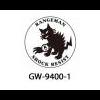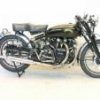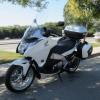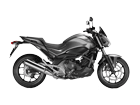Leaderboard
Popular Content
Showing content with the highest reputation on 06/06/17 in all areas
-
Normal my Nc750 gets ridden at speed around the M25 / A2 for most of the 100 mile a day commute, and generally I get 78mpg. over the past week, I have changed by chain / sprockets and also had a 40k service and now, even with me ridding it hard im getting 83/84 mpg. My feeling since the service was a just a oil one, is that running with a chain that was well past it and wearing the from sprocket was adding potentially about 8% mpg hit from friction etc.3 points
-
The correct way is to get a mate of your exact weight and size to sit on the bike. You get down and (assuming a 20 degree day) measure chain pin to swing arm hanging and pushed up. Your mate then walks forwards 6 1/4 inches (assuming standard chain pitch) and you repeat. Repeat again until you have 10 measurements. Average using the Randall-Hopkirk equation and compare to the manual. Repeat after any adjustment. Now get out your laser...... If however you have a life, pop it up on the centre stand (or keep wheeling about if side only), see if you can push the chain up more than the3 points
-
Update!..Honda have come back to the dealer asking for them to send them a video of the chain with the tight spots and also running (I'm sure that's what the guy said).....unfortunately due to work commitments and the dealer being 30 miles away it'll be Thursday the 15th before I get down there. The dealer has asked me to leave the chain as is at the moment and has assured me it will be fine to ride....I won't be doing many miles between times anyway.....I'll keep you updated. Alan.3 points
-
Spoilsport! I'm much easier to convince that it's the fault of the chain. Any chain..3 points
-
Hmmm, and again it all comes down to 'racing'. OK give race bikes chains and road bikes belts - simples - but NO! Road riders want what racers use! And the whole thing goes round again.. (Goes round again chain? Belt? Goes round again? Oh, please yourselves..)2 points
-
Oil the brakes stop all that drag/ friction (only joking, don't oil the brakes )2 points
-
2 points
-
A looser chain is always better than a tight one. As long as its not slapping the underside of the swing arm at mid-point you will be fine.2 points
-
On the face of it it's difficult to argue with your logic, Richard. Bloody chains!2 points
-
Morning all, would anybody be interested in a step by step guide with pictures for changing the airfilter on a 2014 NC750X? I took mine out yesterday for cleaning and took pictures along the way with the intention of doing a guide on here. Its a very simple job really but might make it abit easier for someone?1 point
-
Your first method is almost correct, if using the Randall-Hopkirk equation, you must factor in the day of the week, longitude and latitude, plus the rotational speed of the earth and position of the sun? Only then will you have the correct figure to ten decimal places. Alternatively ask an adult!1 point
-
It was a device alongside the track that could detect overheating bearings in the axle boxes of trains.1 point
-
1 point
-
1 point
-
Folks: how do you actually check the chain tightness at various different positions? I believe you are supposed to check the tightness with the bike on the side stand. However, to do it properly you have to move the bike forward or backward a few times to make sure you've checked all the chain. Is that what you actually do? On my driveway it's a right faff. I've got a centre stand on mine, and would much prefer to check and adjust the chain when it's up on the stand so I can spin the back wheel freely. But I don't know what the slack is supposed to be whe1 point
-
1 point
-
Trams of former times had a pedal for the driver to stamp on when traction was poor. It deposited sand infront of driving wheels allowing Dundee trams to climb some of the steeper routes. Perhaps some similar, but more expensive, dispensing system could help trains?1 point
-
I think it may be weather related, my mpg has surged recently too. (I'm mostly motorway journey as well these days).1 point
-
1 point
-
On my versys i had very rough running after changing the plugs. Hadn't removed the large rag I'd carefully placed over both throttle bodies. Thank God it was a LARGE rag! Anybody need their bike servicing? I'll get me coat...1 point
-
yep same sprockets. however this is the first chain I have changed that I ran it for 8kmiles with a few tight spots, and the only time I have see any wear on the sprocket - wear begin that the teeth on the front sprocket were slightly opened up on one side. I do however ride the bike in 'D'1 point
-
No that was a stupid misquote from a journalist who obviously knew FA about trains and how they work1 point
-
Almost certain this will be the issue. There is often just a gnat's todger difference between getting it to work correctly or either not coming on at all or sticking on all the time. It may be stuck with crud if you haven't been in there to clean stuff recently. A little ACF50 is probably the best stuff to use in these situations, plastic and metal bits needing lube and protection.1 point
-
I had my 600 service done at Chiswick too the week before PoppetM. It surprised me to get an email with a link to a video blog of the walk round inspection of the bike. It's reassuring, in an odd kind of way, as it shows that they care about your bike and by videoing the inspection they are not going to try to mug you for additional work that you weren't expecting at least not without showing you the actual evidence first (not that there was any). A thoughtful touch there Chiswick as it's not something they really need to do either. A txt message to say the bike was ready. A ta1 point
-
A little pick type tool will get seals out its obvious which one goes where as different sizes clean grooves out I use a Dremel with small wire brush clean out with a squirt of brake cleaner I smear a little rubber grease on seals and pistons and don't push Pistons, fully in otherwise bleeding will be a long drawn out affair1 point
-
And make sure it is genuine red rubber grease (vegetable oil based) and not that bicycle crap with added PTFE, its actually lithium based and swells brake seals.1 point
-
The stainless steel piston kits are what I use on my customers machines remember X2 kits and lube up the sliding pins that go inside the rubber bellows with rubber grease not copper grease otherwise they will stick1 point
-
No probs, hope its useful. If like me, you service your bike yourself its worth knowing how to remove the filter. I was daunted by the thought of doing it at first but as you can see its not more than a half hour job. Doing 500 miles a week means i can keep the service costs down by doing it all myself1 point
-
Undo the electrical sensor plug from the rear of the air box lid on the L/H side Looking down at the top of the airbox, you need to undo the 6 Phillips screws holding the lid on, there are two here Two more here And two more which you access from above the battery. Be careful not to drop them on removal ! Once you've undone the 6 screws, and the sensor, remove the air box lid itself to reveal the filter itself ! This is what you should be left with the filter removed! Take car not to drop any bits down the intake Now repeat all1 point
-
1 point
-
Crack on Kris, we like things like that. You can never have too many "how to" guides.1 point
This leaderboard is set to London/GMT+01:00















